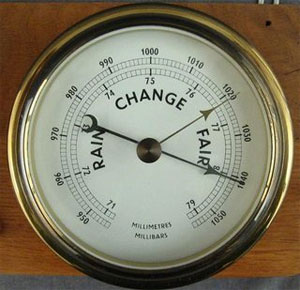Absolute Pressure

A guide to Current Clamp-Meters
October 6, 2022
Wireless Equipment
October 8, 2022We live at the bottom of a sea of air. The weight of air above us creates air pressure in the same way the the weight of the ocean creates pressure on a diver under the sea.


It doesn’t feel like it, as our bodies are used to “pressing back” against this force, but there’s quite a large amount of pressure on us all the time. If we remove pressure from large and small containers, they are instantly crushed just by external air pressure
The video below is a great example of the air pressure crushing a 55 US Gallon Drum.
If we go into space there’s no air, and hence no weight of air. This is an absolute vacuum. Hence when we measure pressure, we need to know if we’re measuring with reference to the ordinary (i.e. air pressure all around us) or compared to an absolute vacuum.
We come across both types of measurement quite often.


The pressures displayed on the weather map (and read on a barometer) are absolute i.e. referenced to absolute zero. Aircraft pilots use the decreasing pressure to measure increasing altitude, again as an absolute measure referenced to absolute zero. At every airport the Automated Weather System (AWS) continually broadcast absolute pressure data for pilots to calibrate their altimeters.

But more commonly, we’re used to using pressure measured relative to the ‘standard’ air pressure around us. E.g. when one pumps up a car tyre to 200 kPa (30 psi), that’s compared to standard air pressure; it’s referred to as “gauge pressure”.
Standard air pressure is defined as 101.325 kPa above a perfect vacuum (at standard temperature and sea level). So when we pump our tyre to 200 kPa (GAUGE), we’re pumping it to 301.325 kPa (ABSOLUTE).
Many industries that work with vacuum e.g. freeze-drying, liquid impregnation etc., need to measure pressure, or in fact vacuum in an absolute sense. For example with freeze drying almost 100 % vacuum is used e.g. 6 mbar absolute. At this very high vacuum, rather than the normal solid-to-liquid-to-gas transition, ice changes directly to steam without passing through the liquid stage (sublimation)).
Vacuum is expressed using various units of measure and you need to understand if you are dealing with absolute or relative (gauge) vacuum measurement.
Refer the chart below


On the gauge shown, pressure is displayed as 0 to 30 ” Hg (but no mention of it being negative) and 0 to -1 bar.
Inches of mercury is often expressed without a minus sign, but is most often vacuum, these are RELATIVE (Gauge) pressure measurements.
So by way of example a 50% vacuum may be expressed as….
- 380 Torr (absolute)
- 506 mBar(absolute)
- -506 mBar (gauge)
- -7.4 psi (gauge)
- -50.7 kPa (gauge)
- 15 ” Hg (gauge) (with no mention of it being negative!)

